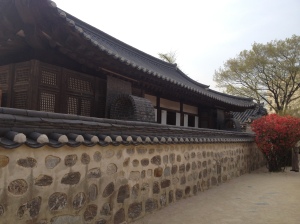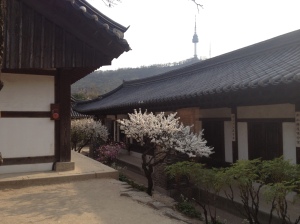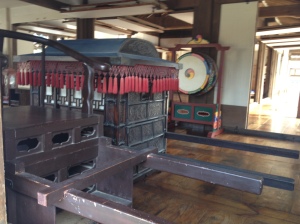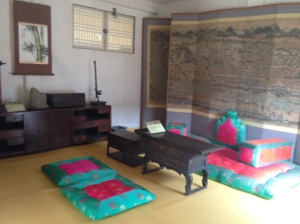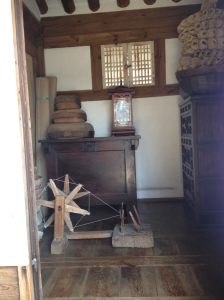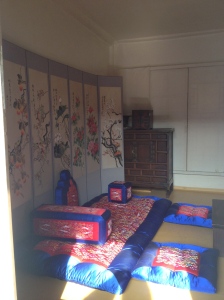Alright, at long last we come to the last of the places that my friend and I visited on our trip to Korea. That place was Namsangol Hanok Village, an immersive recreation of a traditional Korean village from the Joseon Dynasty. Some of the houses are recreations of those owned by the emperor’s extended family, while some are recreations of the houses of peasants.
One thing that continually struck me about Korean architecture at the palaces, temples, and village buildings that we saw was the lack of ostentation. While there are at times evidence of opulence, like the mother-of-pearl furniture in the queen’s quarters at the Imperial Palace and the bright green roof of the emperor’s study, there is very little in the way of grand displays of wealth. The only exceptions I can think of are the crowns that the Shilla royalty would wear. Whether that means such artifacts simply didn’t survive, such things weren’t priorities to the Korean people in those times, the nation didn’t have much wealth, or I just didn’t happen to see them, I don’t know.
Anyway, on to Hanok! All of the buildings represented at the village are houses. Unlike the folk village that I visited in Fukuoka, you can’t go inside any areas of the houses, but fortunately everything is laid out pretty openly so it doesn’t detract too much from the experience. Hanok is basically the place to go if you’re an architecture nut (like I am), if you want to see details of the day-to-day lives of non-imperial Koreans back in the day, or just have a general interest in Korea’s history and culture before modernization.
There were a couple of areas with really pretty gardens, made doubly so since the plum blossoms were at the peak of their blooming cycle. At one of the gardens you can even see Seoul Tower on the mountain in the distance.
In a couple of places outside, you can also see dozens of huge clay pots standing near the gates. I’m pretty sure that these were largely used for making kimchi and other preserves.
I especially liked seeing the kitchens, which had all sorts of pots, pans, and cooking utensils piled up as though ready for use. You can see piles of chopped wood ready to heat the stone stoves, and in fact wood in the heating areas to show how the stoves worked.
There are lots of other interior spaces to look at where you can see details of the domestic lives of the inhabitants. There are what I like to call “traditional garages”, or sites where palanquins and carts were parked, as well as looms, decorative screens and wall-hangings, and all sorts of traditional Korean furniture.
On the day that we visited they were also having some sort of exhibition about Chinese medicine. There was a display of about thirty different ingredients, preserved in jars and labeled in both Korean and English. There were all sorts of roots, some enormous mushrooms, and a good-sized tortoise shell.
There were even some dried seahorses!
A young woman in traditional Korean garb was manning the display and she asked if we had any questions about the medicines. I asked her what the seahorses were used for, and she told me they were given to women in labor to help them push. Interesting. I asked her about some other things, too, which she helpfully explained. When I asked her about the tortoise shell she said, “Oh. That’s for decoration.” I had to laugh.
Afterwards she asked if we’d like to try some herbal tea. Never one to turn down anything that’s free, I readily agreed, only to find out that we first had to determine whether we have “hot” or “cold” temperaments. She gave us sheets of information with different behavioral traits to help us figure it out. I told her that I seemed to have half of the hot and half of the cold traits, to which she replied, “Well, let’s put it this way: do you like cinnamon or mint?”
Well, I still don’t know which temperament I am, but the tea was decent enough. It wasn’t hard on my stomach at all like some Chinese teas tend to be.
Near the entrance to the building recreations there are a few traditional Korea games set up that visitors can try. One of them was the arrow-throwing game, where you try to throw an arrow into a metal ring that has a circumference about the size of a standard cup. We were using fake arrows, but you just know that back in the day kids were probably throwing real arrows around in their yards, never thinking they might take someone’s eye out. Man, I grew up in the wimpiest generation.
Anyway, the only reason I bring this game up is that my friend and I played it and I beat him by actually getting the arrow into the cup. Yeah!
And that about does it for my experience of Hanok Village! There are a few other things to check out there, including a traditional Korean craft shop, a time capsule, and even performances of traditional Korean weddings. I had no idea they had wedding performances, or I might have hung around to see one. Anyway, overall, even just spending an hour or two there is a great way to learn about everyday life in the Joseon period, so I’d definitely recommend it.
I’ve been blogging about my Korea trip for about a month now, so I guess it’s about time I wrapped it up, but I’m not done quite yet! I’ve still got some SWAG to discuss, so look forward to a shallow and materialistic post about my capitalist exploits!


